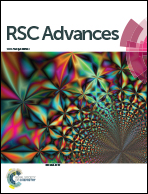Anisotropic growth of Ni3(BO3)2 nanowhiskers on nickel substrates and its application in the fabrication of superhydrophilic surfaces†
Abstract
One-dimensional (1D) single-crystalline nickel borate [Ni3(BO3)2] nanowhiskers were successfully grown on Ni substrates using the facile molten-salt method in air with MnO2 as the agent. The products were characterized via X-ray diffraction, scanning electron microscopy, and transmission electron microscopy. The Ni3(BO3)2 nanowhiskers that were synthesized at 950 °C, with diameters ranging from 120 to 250 nm and lengths of up to 50 μm, possessed an ultra-high aspect ratio (more than 100 : 1) and were found to grow along the [021] crystallographic direction. The effects of the growth temperature, holding time and amount of agent on the product morphology were investigated in detail. The products retained a nanowhisker morphology at growth temperatures below 1000 °C but transformed into microtubes when synthesized at 1050 °C. The oxygen liberated by the manganese oxides facilitated the nucleation of Ni3(BO3)2 nanowhiskers. In addition, the surfaces coated with the Ni3(BO3)2 nanowhiskers exhibited good superhydrophilic properties, and the wetting dynamics of such surfaces was investigated.


 Please wait while we load your content...
Please wait while we load your content...